Welcome to this year’s deep dive into AgileSherpas’ annual State of Agile Marketing Report. As this is our seventh consecutive year of fielding a survey and compiling the results, I’ve personally built up a lot of expectations about what we’ll find each spring.
Sometimes those expectations are accurate. Data validates my assumptions and I get to feel smart about my in-depth knowledge of the Agile marketing movement.
Other times I feel less smart. The data proves me wrong and points me in a completely different direction.
This year both things happened.
There are some things that I was glad to see, and which aligned with what I thought we’d find. There are other things that I’ve not seen in our seven years of doing the State of Agile Marketing Report, which reminded me that nobody can know everything about anything, and that being surprised is fun.
My job on this page is to take you way deep down into the data we collected.
Some of what you’ll encounter can be found in the “official” State of Agile Marketing Report, but other things were in our data but didn’t make the cut for the report itself.
If I have a hypothesis about why certain data points ended up where they did, you can be sure I’ll share it. If, on the other hand, I haven’t the foggiest idea why something looks the way it does, I’ll be honest about that too.
For those interested in the year-over-year perspective on all things Agile marketing, you can check out the past years’ deep dives here:
2018
2019
2020
2021
2022
2023
And with all that context in place, let’s dive in.
What Matters to Marketers in 2024
Some of the data we collect is particular to marketers who label themselves “Agile,” but other pieces apply to marketers regardless of their ways of working.
One fascinating trend in this area for 2024 was the growing emphasis on customer centricity:
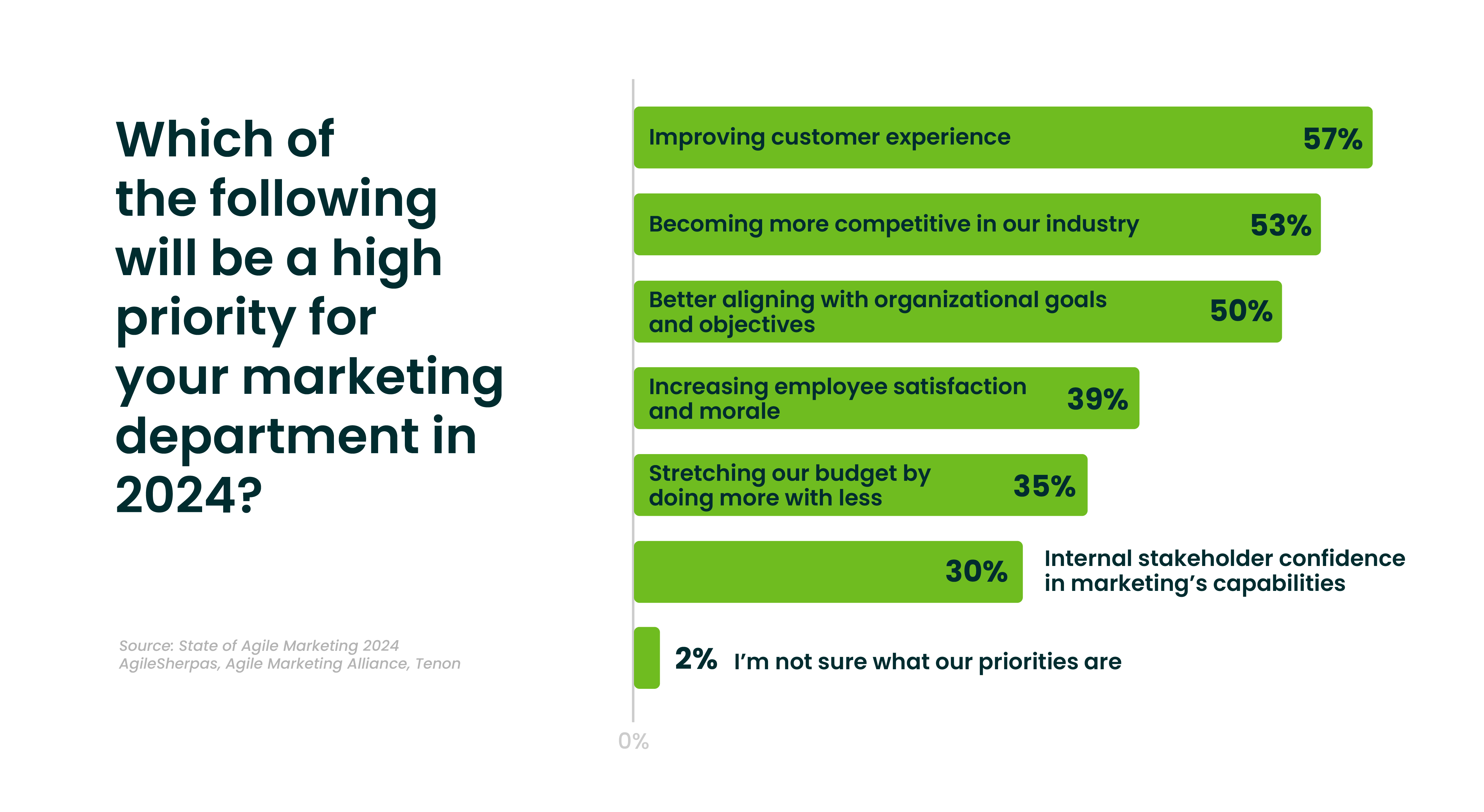
As you can see, improving CX was actually the top priority this year. And, since one of Agile’s key goals is to deliver more customer value faster, it makes sense that marketers are turning to Agile processes to help achieve this goal.
Of course, we wouldn’t run this report at all if everything was great in marketing operations land. Whether they’re Agile, traditional, or ad hoc, marketers are plagued by last-minute requests:
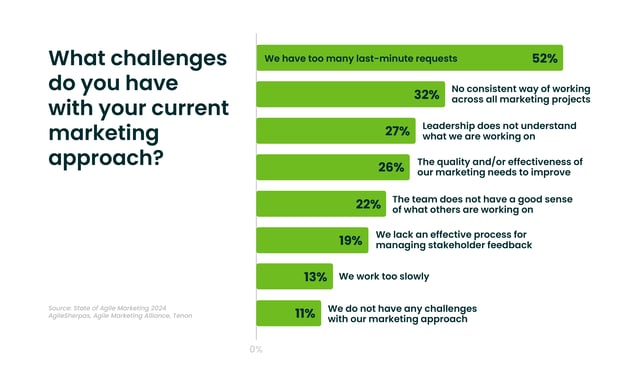
The bottom line is that marketers can’t predict where our next request is coming from, what its deadline will be, or who’s going to ask us for it.
If we want to accomplish our goals, we need a flexible, adaptive, responsive approach that’s aligned with the realities of our workday.
Many of us are turning to Agile to help.
Agile Marketing FTW
We often say that Agile should not be anyone’s “why.” No one should undertake the difficult, complex, and expensive process of Agile transformation without a very good reason, and “so we can be Agile” is not a very good reason.
So both with our clients and in this report, we try very hard to push for a deeper understanding of what “why” is for marketers.
This year we asked marketers to tell us in their own words what drove them toward agility, and we heard things like:
“Since the start of Covid, we have had to become more agile in order to make sure our business can respond to the changing playing field we find ourselves on. It seems as though if you stand still too long the ground literally crumbles and you're caught napping. If a marketing campaign is to work then you have to be ready to respond to all turns as soon as they appear.”
“The fast pace of technology that we market forces us to adapt to market changes and social interest. We move focus and funding as importance dictates.”
“We work for a large organization which often changes targets and budgets so we need to adapt quickly.”
Looking beyond specific open-text answers, we see clear themes in the associations marketers have with agility:
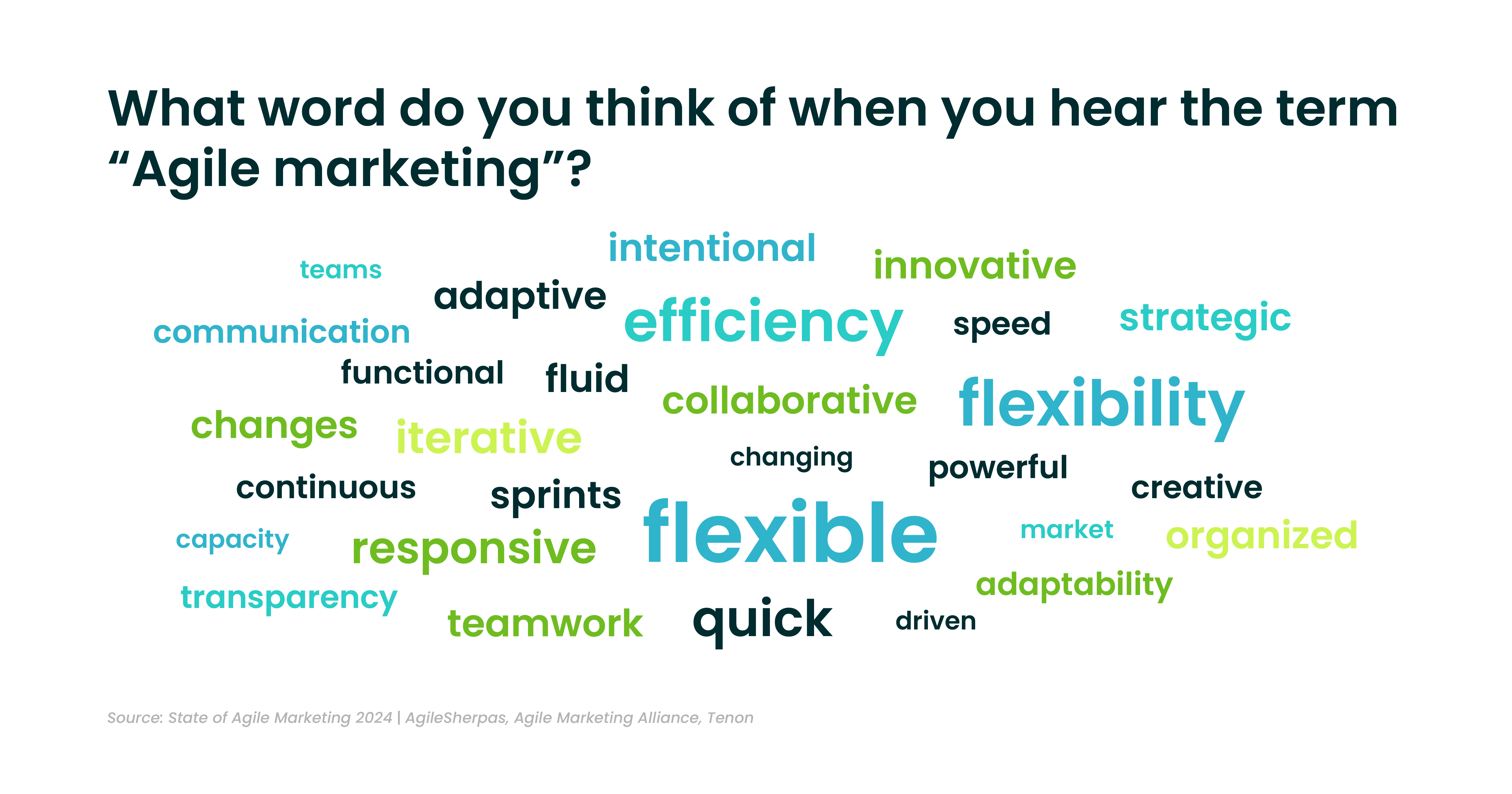
Marketers need to be responsive, but not overly reactive. Change is a constant in our lives, and for many of us Agile is the answer.
And these “why” statements aren’t just aspirational. The overwhelming majority of our Agile respondents love their processes.
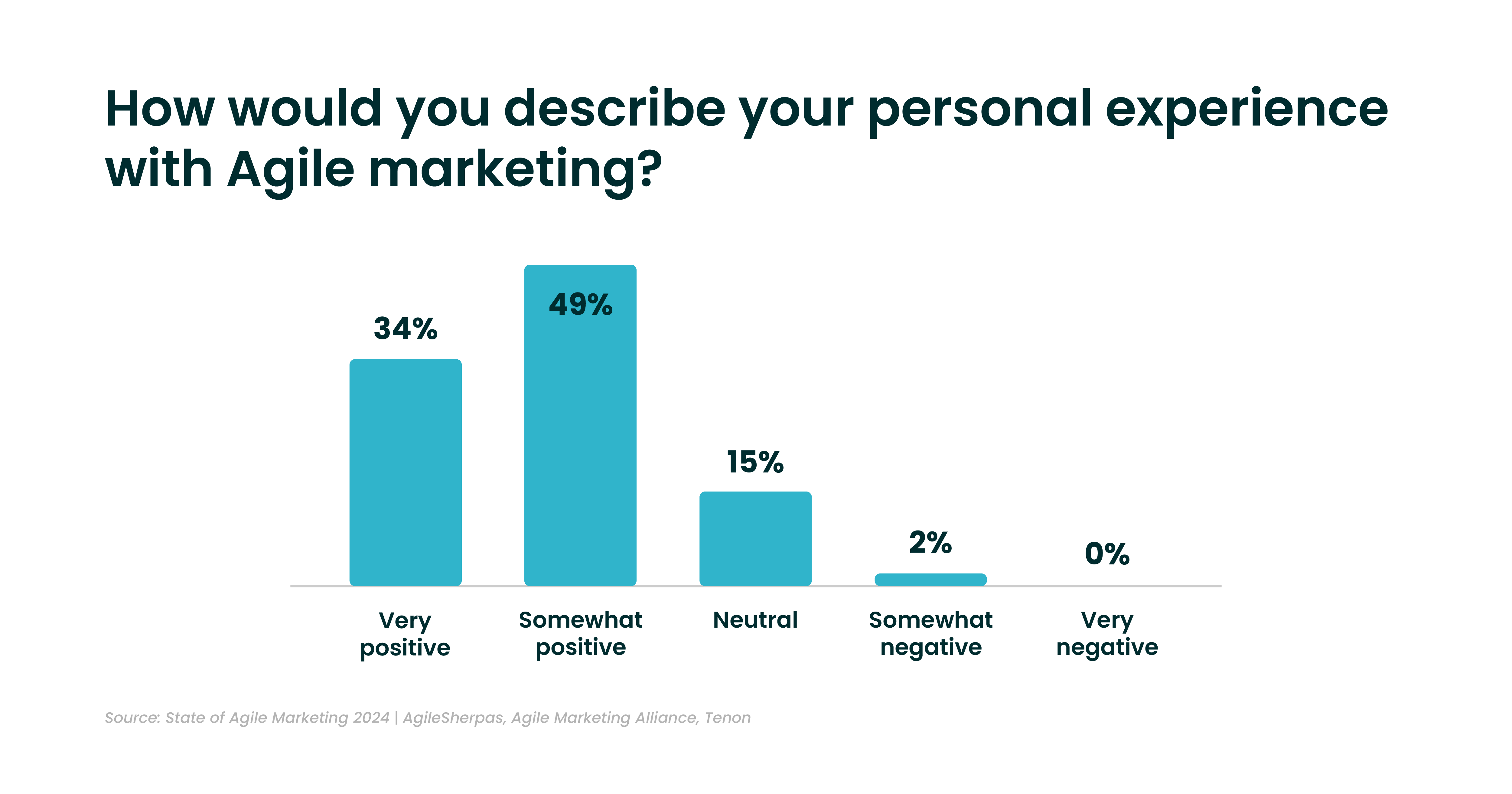
Literally, nobody said they’ve had a very negative experience with Agile, and only 2% say they’ve had a somewhat negative experience.
As we get into the growing maturity of marketing agility later in the article, we’ll see how these positive experiences seem to be driving a larger number of Agile marketing teams, as well as longevity of Agile transformations.
How to Win at Agile Marketing
Of course, simply “doing Agile” isn’t a recipe for success. We’ve collected tons of data points about what the best-in-class Agile marketers are up to.
Most Agile marketers feel pretty good about their implementation, with 82% saying they’ve been extremely or very successful. That’s a great win rate, but it’s worth getting a better understanding of what good looks like in 2024.
Here’s one component from this year that I definitely wasn’t expecting:

Since the inception of the State of Agile Marketing Report, marketers have overwhelmingly preferred to build their own adventures when it comes to frameworks.
This makes absolute sense, because “off the shelf” versions weren’t made with marketers in mind.
But in 2024, for the first time ever, we don’t have a clear winner in the framework fight.
Kanban, Scrum, and Hybrids are all completely tied, and even Lean is hardly differentiated. What are we to make of this swing?
My hypothesis is that as Agile marketing matures, we’re getting more comfortable with established framework options. We know how to adapt Scrum, Kanban, or Lean to work for us, so we’re OK borrowing those approaches in their entirety.
Marketers are also diversifying the practices they use, which may be related to the overall “smoothing out” of the adopting across frameworks:
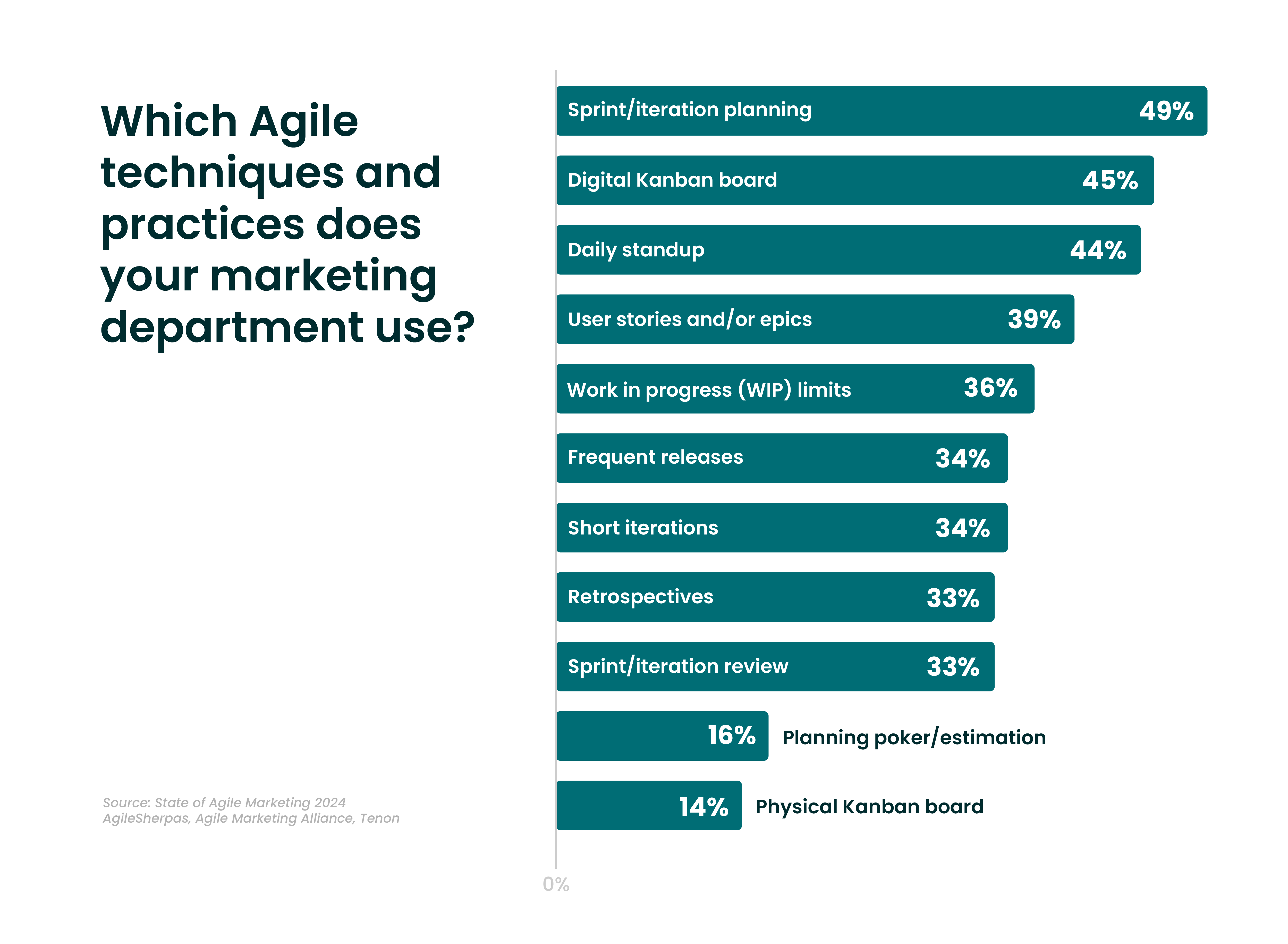
This is another data point that gets particularly interesting if we look at it over time:

While we’re clearly seeing a broader use of traditional Agile frameworks by marketers, we’re still big fans of mixing and matching our practices.
But the real insight from this data comes from the highly successful Agile marketers. We want to know how they’re managing their work so we can all follow suit!
Here’s what we found out this year:
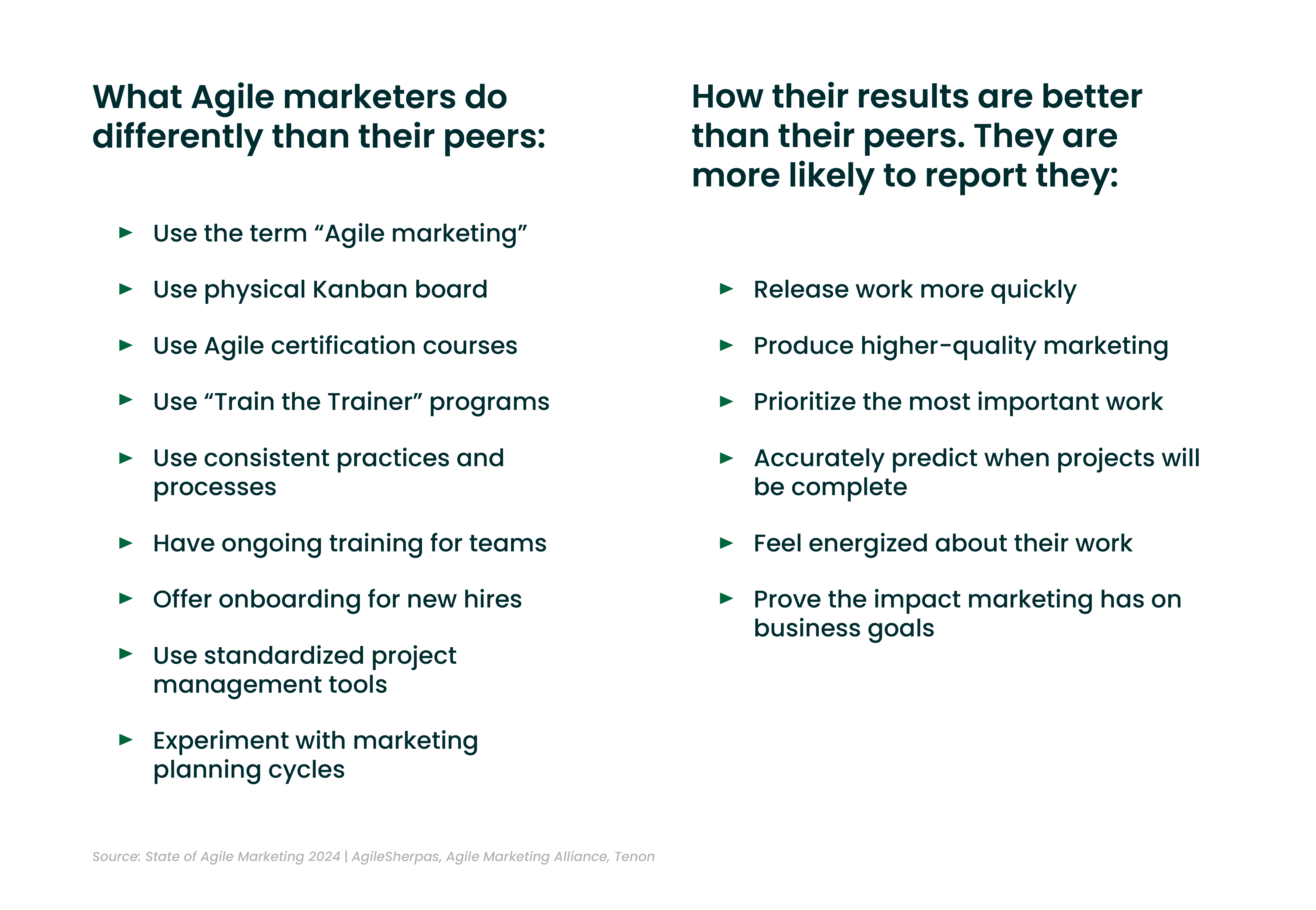
As we compare this to the ways that marketers support their transition to Agile, we start to see some clear gaps.
For instance, 78% of the marketers who leveraged “train the trainer” programs found them valuable (as shown below), but only 23% of marketers used those programs.
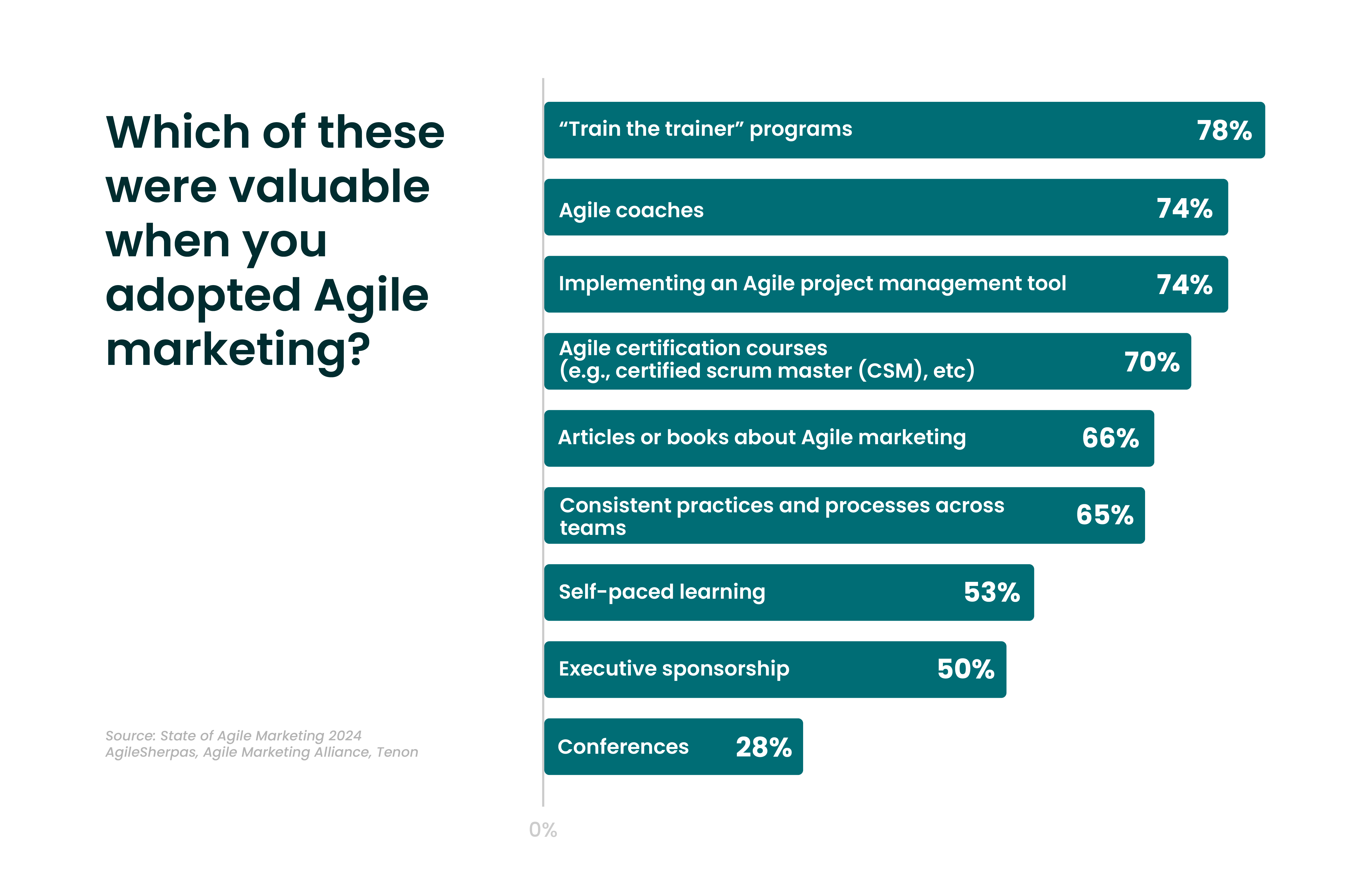
These programs embed key capabilities for supporting the long-term adoption of Agile ways of working, such as coaching or facilitation. It makes total sense that those who use them are very happy they did.
Yet over three-quarters of marketers failed to take advantage of this tool.
We see similar trends across multiple areas:
- 74% of those who implemented a project management tool found that valuable, but only 38% of Agile marketers did so
- 74% of marketers who got coaching saw value in that relationship, but only 28% of marketers used coaches
- 70% of marketers who earned certifications are happy they did, but only 35% got new letters after their names on LinkedIn
What I personally see when I read these comparisons is that for some reason marketers like increasing the difficulty level of our Agile adoptions.
There are tons of resources out there that we can use to make our lives easier, yet we insist on doing it the hard way.
For future years, let’s not make this harder than it needs to be!
Maturing Uses of Agile Marketing
One thing we’ve asked over the past few years is how long our respondents have been practicing Agile marketing. Looking back on the last four years, we can see an expected shift from newer adoption levels (1-3 years) toward more mature, in-depth adoptions (3 or more years):

This is one of those data points that we expect to see trending in this direction, as more teams get past their pilots and scale into the entire marketing function.
Likewise, we see slow but steady growth toward full adoption, which we would expect given the positive experiences that marketers tend to have with agility:

Getting beyond raw numbers, we can see that many marketing organizations are in the midst of moving most, if not all, of their marketers toward Agile.
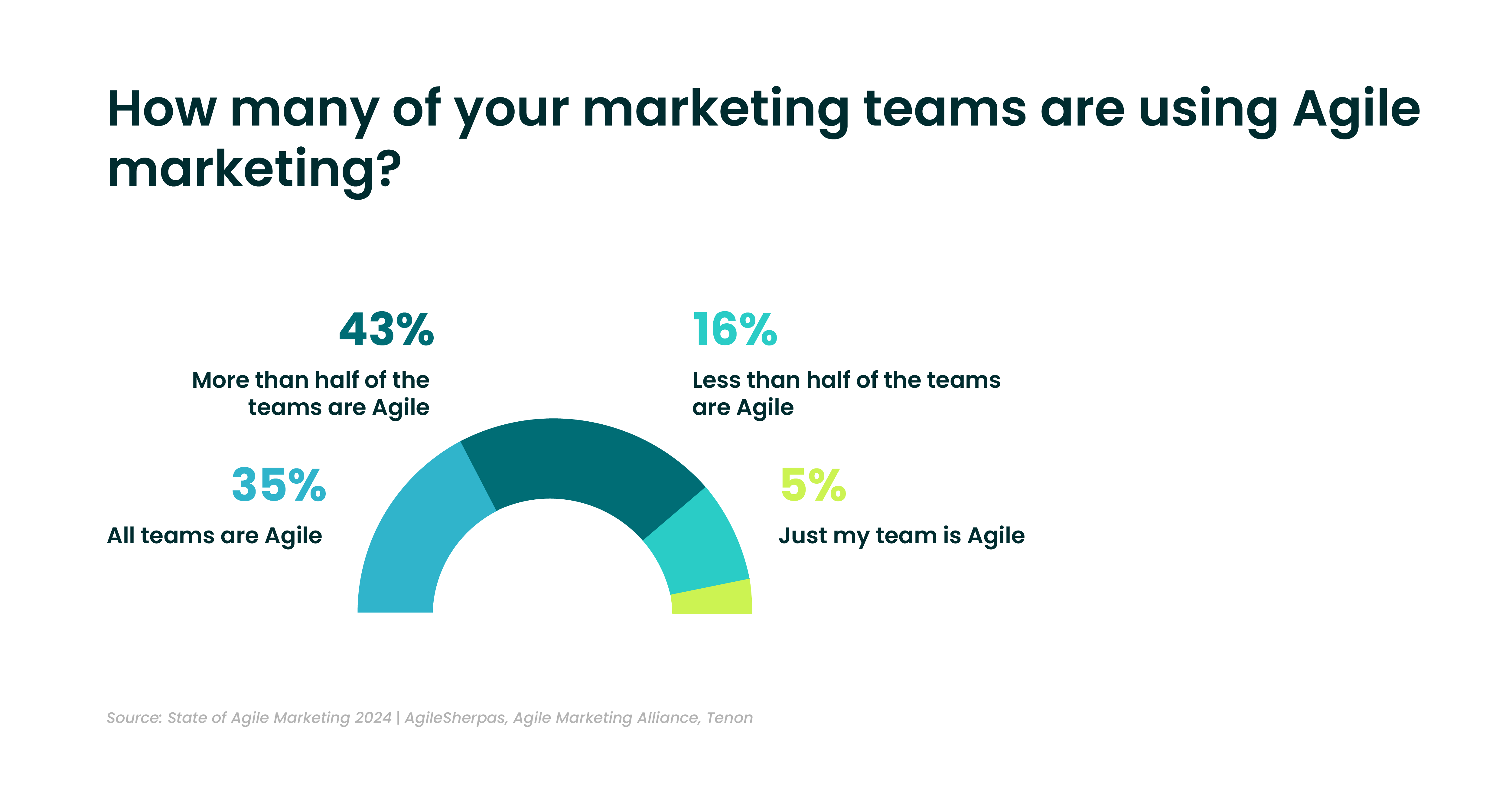
Only 16% of this year’s respondents say they’ve got less than 50% adoption, and well over half are planning to transition additional teams:
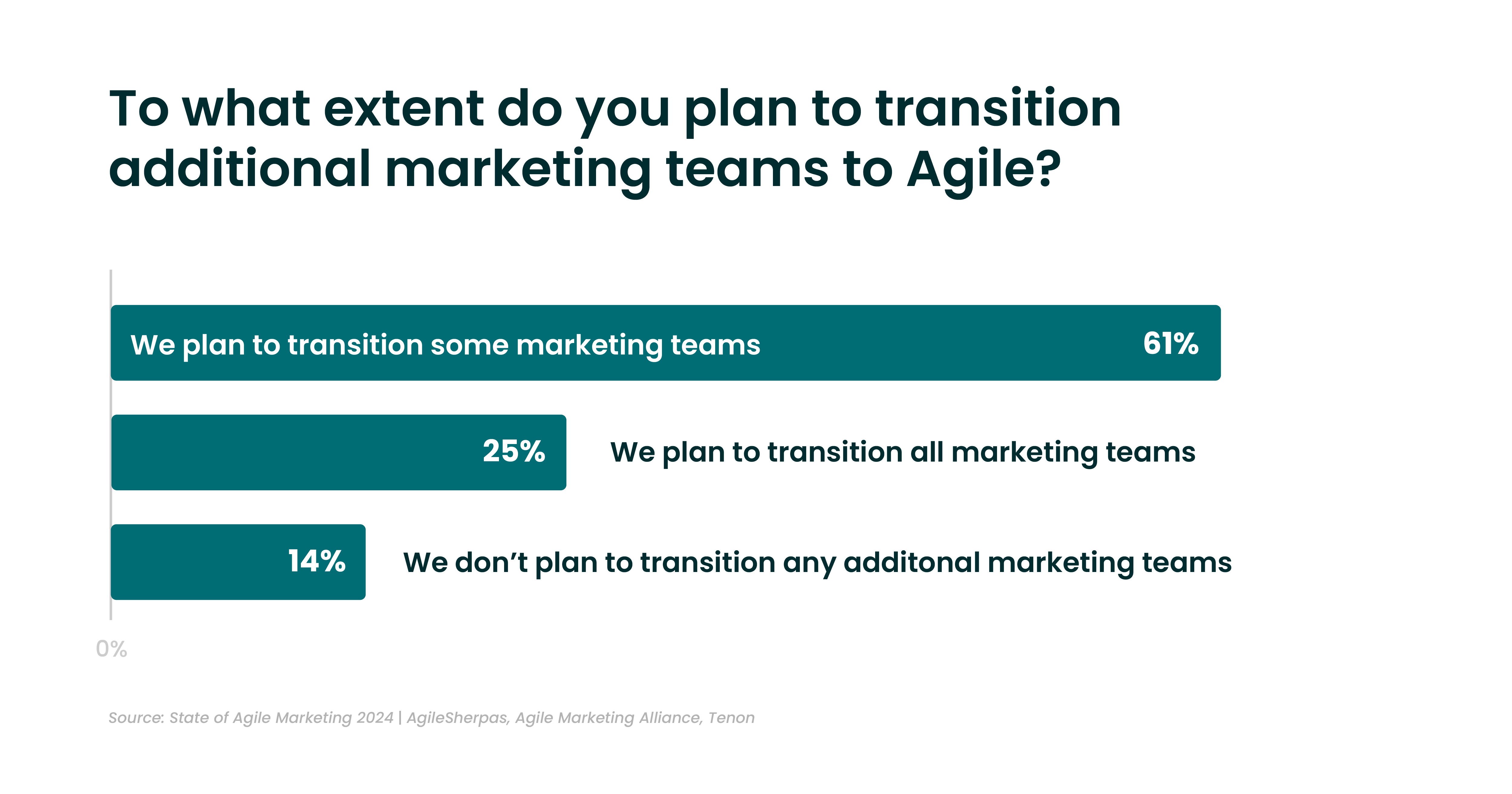
If we consider the dual trends of maturation and positive experiences, it makes sense that we’ll soon see a greater tendency for entire marketing functions to use Agile.
Experiments in pockets are great ways to get started, but the real value and benefits come from aligning everyone around shared ways of working.
What’s Getting in Our Way?
I want to close out with two final data points: the biggest barriers marketers are facing, and the tools we use to manage our work.
Last year I was concerned, because the top barrier our respondents cited that was holding them back from achieving greater agility was a sense that their current processes were OK. This year, that reason fell to number three:
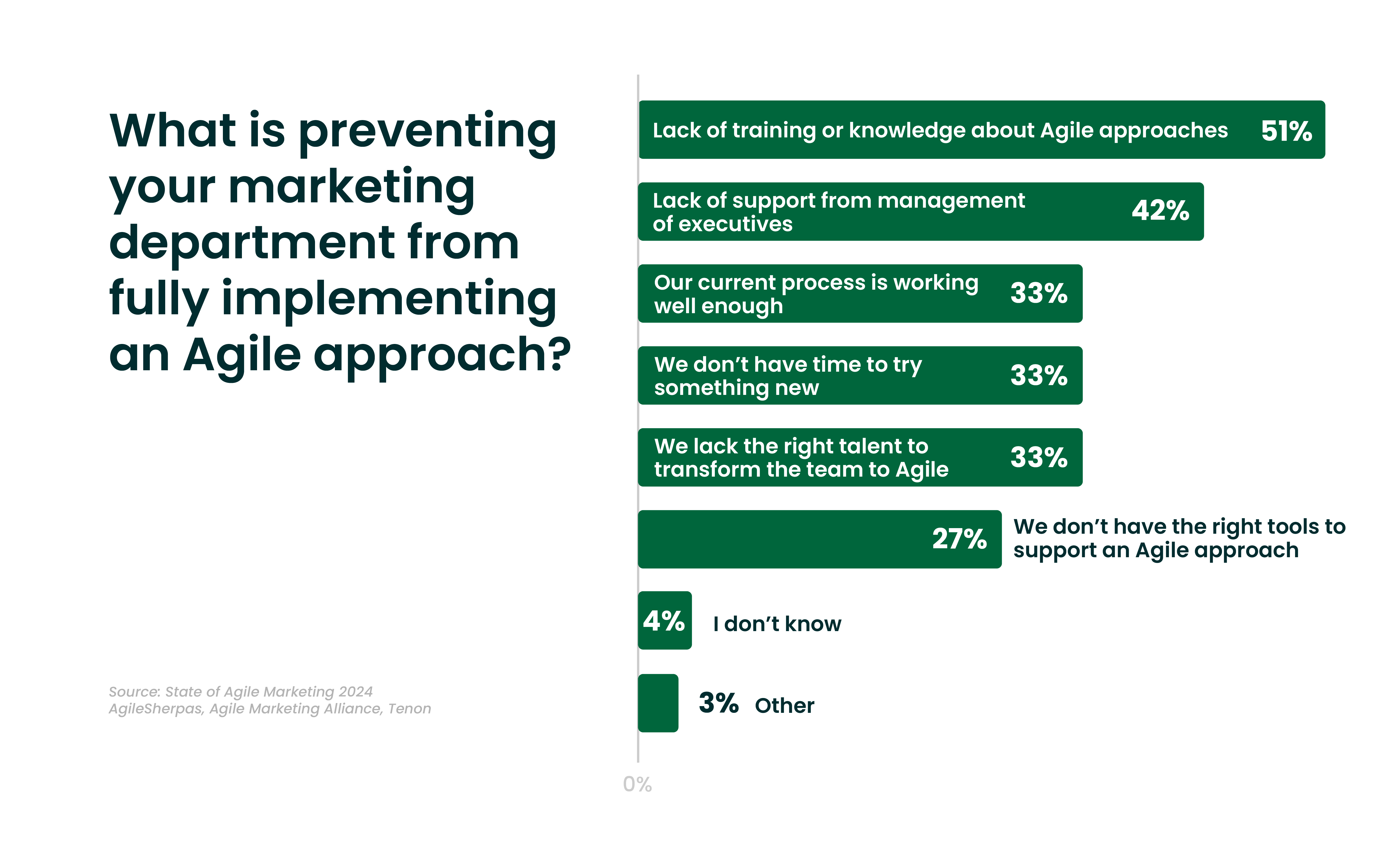
I’m glad to see this, because the last time the status quo was the biggest barrier was 2020, right before the pandemic. It’s good that it didn’t take a similarly catastrophic event to shake us out of our complacency this time.
And, selfishly, I like seeing a lack of training at the top of this list. Partially because AgileSherpas offers all kinds of training to solve exactly this problem, but also because this is a very solvable problem.
A lack of support from management or executives is a little harder to tackle, but it’s still manageable. Complacency is tough to combat, so I’m happy to see it falling down the list.
And we also need to talk about tools:
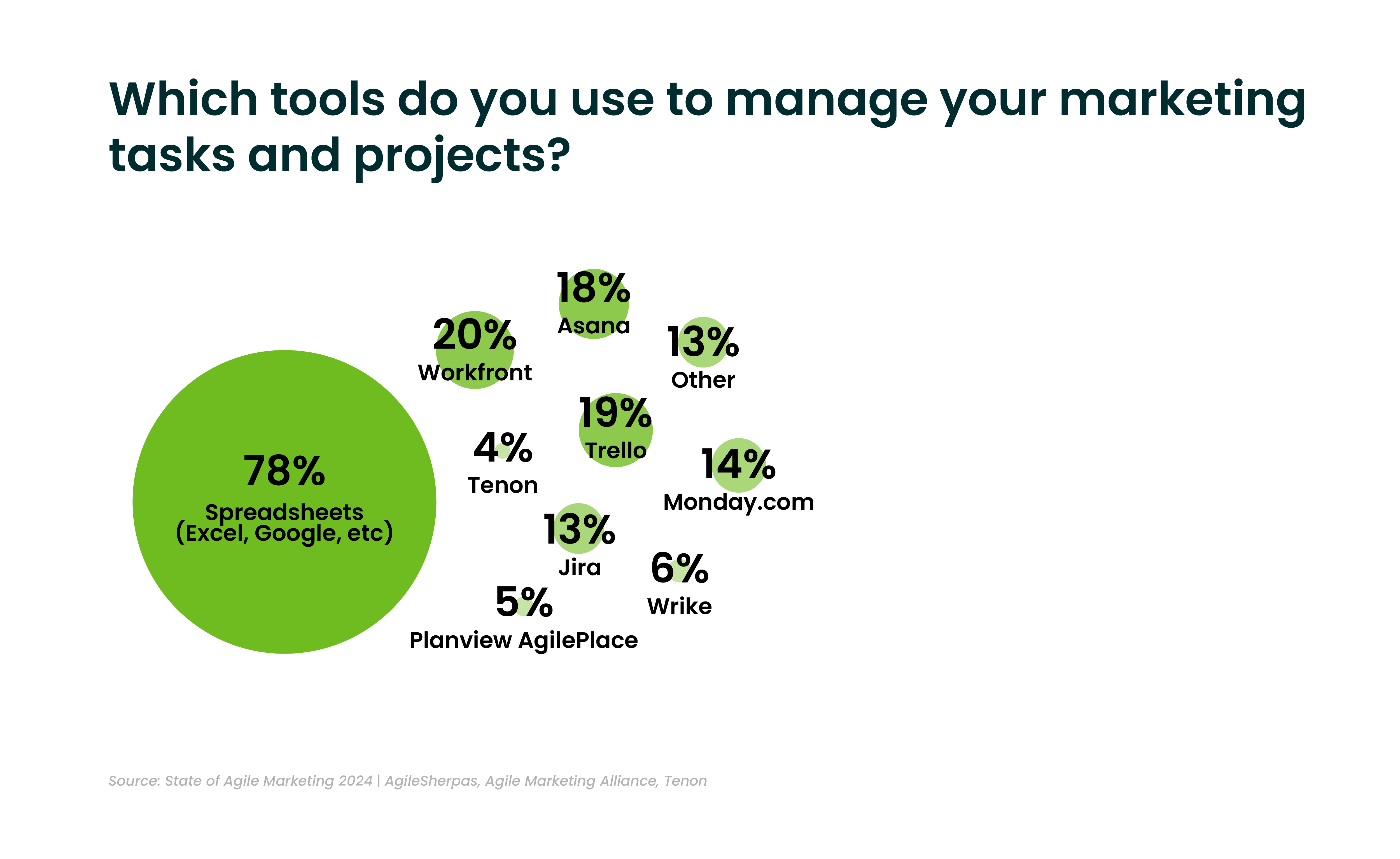
I understand that spreadsheets are a known entity. They’re not overwhelming, we don’t need IT’s approval to use them, and everybody already has them on their computers.
But seriously, we need a better approach to workflow management.
Take the time to investigate the options and get something (almost) everybody can live with. Our good friends at Tenon are even building an Agile tool just for marketers!
When it comes to agility, spreadsheets (ironically) make data analysis much trickier, they don’t give you the flexibility and granularity that you need, and they make it harder for everyone to take ownership of their work items (because there’s usually one person who runs the spreadsheet).
There are lots of things we can’t fix as modern marketers, but both these barriers are very, very manageable.
I can solve the training one for you right now:
- Free and low-cost learning options in our online academy, The Ropes
- Certifications for Agile marketers and their leaders
- Mastering Marketing Agility, a book all about an Agile framework tailored for marketers, and how to implement it
- This totally free Agile Marketing Quick Start Guide
Look! We fixed it!
As for the tools issue, check out Tenon. I can also recommend Trello, Asana, Monday, and Kanban Zone from personal experience. Find one that jives with your team’s needs and budget, and please don’t rely on spreadsheets for your workflow management.
So yes, I’m leaving you with a bit of homework, but what did you expect from a blog riddled with charts and spreadsheets?
Do the legwork, and you’ll be rewarded with the same high success and satisfaction rate that other Agile marketers enjoy, along with the consistently realized benefits of quality, speed to market, predictability, and job satisfaction.
Before you leave, get you copy of the 7th Annual State of Agile Marketing Report.